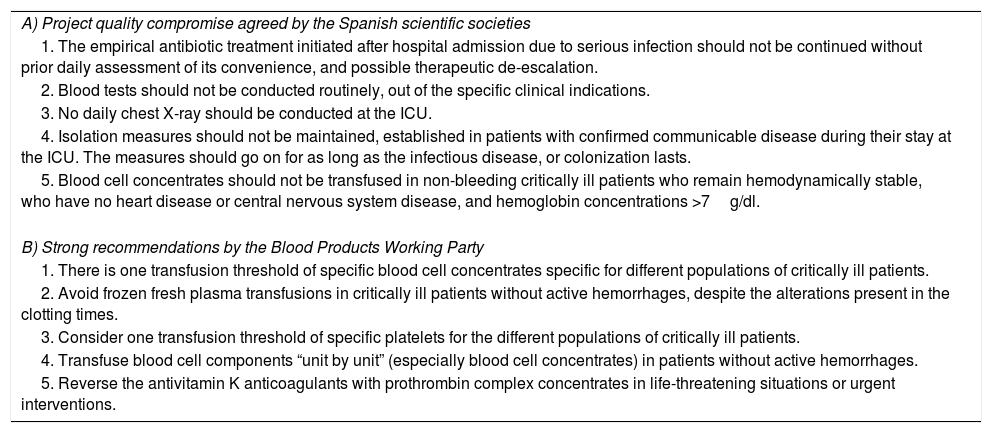We have read with great interest Chacón-Alves et al.’s work1 on post-transfusion hemolysis in anemic critically ill patients who are stable at 72h. We wish to congratulate the authors for their new approach. We share with the authors their worry on the effectiveness and safety of allogeneic blood transfusion (ABT) that should be administered not for the management of anemia, but “to transfuse the minimal necessary amount to reverse the symptoms and signs of hypoxia or reach safe concentrations of hemoglobin (Hb) based on the clinical characteristics of each patient at a given time”.2 The ABT is a transient measure, and we should not just treat one analytical number, because we could end up having the same need if we don’t treat the cause. We propose a change toward the paradigm of “optimal or adequate use”.2
Above all, when it comes to the methodology used and results from their work, we would like to know whether they considered several risk factors associated with the ABT of packed red blood cell (PRBC) concentrates. Has the age of the PRBC concentrate been registered? The age has been related with a lower viability of erythrocytes. In some countries and several Spanish autonomous communities, the expiration date of PRBC has been dropped to 35 days, and attempts have been made to make it go further down to 28–31 days only. Also, the age of the PRBC concentrate has been associated with a higher risk of hyperkalemia, the appearance of post-transfusion cardiovascular events,3,4 and respiratory distress. Have the levels of post-transfusion potassium been estimated? Was the higher or lower compatibility of the PRBC administered, or the presence of irregular antibodies ever analyzed?
Similarly, we would like to know if the effectiveness of transfusion could be confirmed: if the increase of transfusion Hb observed was the same or higher than expected. Also, we would like to know if the volume and content of Hb of the PRBC concentrate administered and their association with the increase of post-transfusion Hb and degree of hemolysis found were analyzed; also, if this increase was adjusted to the patient's weight and volemia. Also, it would be interesting to know how many patients eventually needed a second PRBC concentrate. The administration of one single PRBC concentrate can be a valid option.2
Besides, taking into consideration the recommendations established by the American Association of Blood Banks (AABB),5 and the Blood Products Working Party (BPWP)6,7 (Tables 1 and 2), of reducing or minimizing unnecessary blood transfusions—to avoid “vampirism”, and conducting them early in the morning, we would like to know whether there were any differences compared to the concentration of Hb the next day.
Recommendations from the Spanish Society of Intensive, Critical and Coronary Unit Medical Care.
| A) Project quality compromise agreed by the Spanish scientific societies |
| 1. The empirical antibiotic treatment initiated after hospital admission due to serious infection should not be continued without prior daily assessment of its convenience, and possible therapeutic de-escalation. |
| 2. Blood tests should not be conducted routinely, out of the specific clinical indications. |
| 3. No daily chest X-ray should be conducted at the ICU. |
| 4. Isolation measures should not be maintained, established in patients with confirmed communicable disease during their stay at the ICU. The measures should go on for as long as the infectious disease, or colonization lasts. |
| 5. Blood cell concentrates should not be transfused in non-bleeding critically ill patients who remain hemodynamically stable, who have no heart disease or central nervous system disease, and hemoglobin concentrations >7g/dl. |
| B) Strong recommendations by the Blood Products Working Party |
| 1. There is one transfusion threshold of specific blood cell concentrates specific for different populations of critically ill patients. |
| 2. Avoid frozen fresh plasma transfusions in critically ill patients without active hemorrhages, despite the alterations present in the clotting times. |
| 3. Consider one transfusion threshold of specific platelets for the different populations of critically ill patients. |
| 4. Transfuse blood cell components “unit by unit” (especially blood cell concentrates) in patients without active hemorrhages. |
| 5. Reverse the antivitamin K anticoagulants with prothrombin complex concentrates in life-threatening situations or urgent interventions. |
Do-not-do recommendations from the American Association of Blood Banks (AABB).
| 1. Don’t transfuse more units of blood than absolutely necessary. |
| 2. Don’t transfuse red blood cells for iron deficiency without hemodynamic instability. |
| 3. Don’t routinely use blood products to reverse warfarin. |
| 4. Don’t perform serial blood counts on clinically stable patients. |
| 5. Don’t transfuse O negative blood except to O negative patients and in emergencies for women of child bearing potential with unknown blood group. |
Source: Callum et al.5
Finally, we would like to know whether the transfusion protocol included the administration of pre-medication, and whether this medication was administered to all patients or just a selected few, and whether some post-transfusion diuretic was administered as well. If so, we would like to know if these medications administered were in the results found.
We don’t want to bid farewell without reiterating our congratulations and commitment to collaborate conducing one multicenter study.
We wish to thank the transfusion centers that provide us with the best and most fresh blood components.
Please cite this article as: García Erce JA, Quintana Díaz M. Hemólisis, hipercalemia y transfusión de concentrados de hematíes viejos en pacientes críticos. Med Intensiva. 2018;42:261–262.







